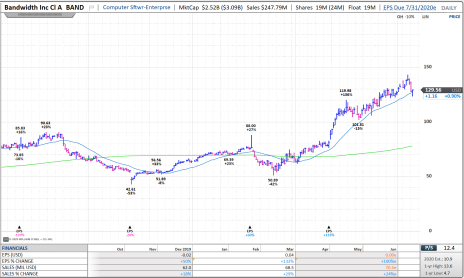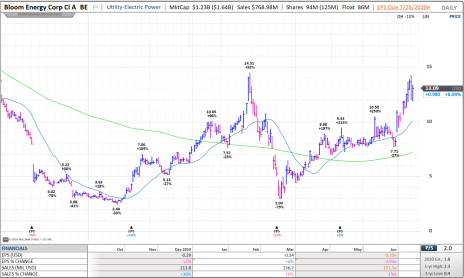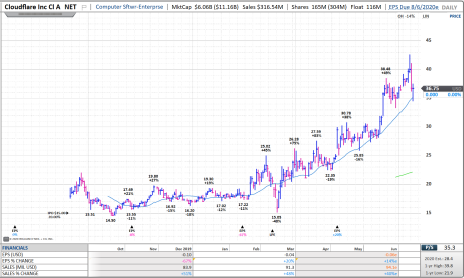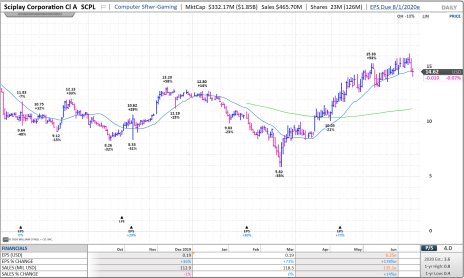Technology stocks took a hit on Monday when the Nasdaq posted a concerning reversal. However, the current evidence doesn’t yet suggest that we should be moving materially more conservative. That said, we’re not going to chase every hot stock right now. This month’s Issue of Cabot Early Opportunities seeks to offer a balance of rapid and modest growth from fresh faces, including some that have yet to break out and run wild (as many tech stocks have).
Cabot Early Opportunities 111
| Stock Name | Market Cap | Price | Investment Type |
| Bandwidth (BAND) | $3.1 billion | 129.56 | Growth – Comm. Software |
| Bloom Energy (BE) | $1.6 billion | 13.09 | Growth – Fuel Cells |
| Cloudflare (NET) | $11 billion | 35.75 | Rapid Growth – Security Software |
| Schrodinger (SDGR) | $5.2 billion | 83.63 | Rapid Growth – MedTech |
SciPlay (SCPL)
| $1.9 billion | 14.62 | Growth – Online Gaming |
The Grand Experiment Continues
As we move into the heart of the summer uncertainty is on the rise.
As if the upcoming election isn’t enough, we’re seeing rising cases of Covid-19 across many areas of the country, and parents have absolutely no idea what’s going to happen with schools.
I’m on the board of a small private school in our town and I can tell you this with confidence — regardless of what school systems are saying publicly, decision makers know this is one grand experiment that has no reliable data upon which to base decisions. Any decisions that are made today could easily change in a week, let alone in a couple of months.
The reality is that over the next year or so many families will have to make tough decisions about what to do poorly – their jobs, parenting, or educating. That’s going to continue to be a big drag on elements of economic activity, in my view—not to mention a drag on mental health.
At the same time, there are a lot more factors affecting the economy than what conflicted parents do! And for some families, the potential flexibility of less time with kids in the classroom opens opportunities.
Obviously, a lot depends on travel restrictions and health trends in different places, but I think we’re going to see more cases where families do more things based on the lifestyle they want to live, not based on a school calendar.
For example, if kids are hardly in school anyway, why not take a trip, or engage in activities of your choosing, whenever you want? Naturally, if the economy tanks this will be difficult for many families. But not all.
For investors, the bright side (if there is one) of the current “virus curve” is that if the pandemic continues to curb economic growth we still have the Fed. Remember, Fed Chairman Jerome Powell has shown a willingness to “do whatever it takes” to keep things clicking. He has gone further, faster, than Greenspan, Bernanke or Yellen.
I don’t think it’s an overstatement to say the market is where it is because of the Fed. Or that upside potential is a result of what the Fed has shown a willingness to do.
In other words, this Grand Experiment continues.
What to Do Now
Same as last month, try to keep an open mind.
We’re going to continue to buy into attractive stocks despite all the uncertainty. I don’t expect they’ll all work out in the immediate future, but by culling underperformers and trying to focus on what’s working, the steady implementation of our strategy to buy early-stage growth stories should continue to deliver market-beating returns.
In terms of last month’s additions, until this week most of our new stocks were in the black. Now, we have a mixed bag. With the exception of Tela Bio (TELA), which we stepped aside from in late June due to poor performance, all of our stocks are currently either modestly up, or modestly down.
Bill.com (BILL) is the current leader, up 7% from our entry point even after a sharp correction. Purple Innovations (PRPL) is just above break-even, while OneWater Marine (ONEW) is down 2% and SelectQuote (SLQT) is down 10%. Given that SelectQuote is such a recent IPO I expect the stock will continue to be quite volatile for several months.
This month’s Issue of Cabot Early Opportunities features a fresh group of stocks that offer varying risk profiles and exposure to rapid-growth markets.
We have a company with a disruptive security platform that acts as a guardian of the internet, a MedTech innovator with two exciting growth businesses, a clean-energy stock looking to put a troubled past behind it, a little-known gaming company and another software player that’s offering crucial communication services during the pandemic.
Enjoy!
STOCKS
Bandwidth (BAND)
Bandwidth (BAND) is a $3.0 billion market cap company that has developed one of the leading cloud-based communications platforms for large enterprises. This platform helps Bandwidth’s customers build, scale and operate software-based voice, messaging, and emergency service-related communications tools.
The industry term for its delivery model is Communications-Platform-as-a-Service (CPaaS).
Among many other use cases, customers can develop new mobile applications that allow them to send Application-to-Person (A2P) messages, receive Person-to-Application (P2A) messages, add voice calling to residential Internet of Things (IoT), and develop innovative 911-calling solutions that improve emergency response times by automatically identifying the call-from location with pinpoint accuracy.
Suffice to say these are all very helpful solutions in a world where hardware phone systems are declining, and the Covid-19 pandemic is driving demand for more flexible communications systems.
For example, corporate conference rooms might have a cloud-enabled conference system and no landline, but they still need 911 services. Also, when the pandemic first broke out calling demand surged as more people began to work remotely and health care systems, schools, businesses and more needed flexible communications systems. Bandwidth delivered.
One of the reasons for its competitive advantage is that Bandwidth owns its own tier 1 network. That makes the company more similar to the legacy network providers, like Verizon, AT&T and CenturyLink, than the other CPaaS players, such as Twilio (TWLO), which runs its platform on infrastructure provided by the network providers.
This does mean higher overhead, but as the pandemic has shown the agility to add capacity in real-time, while maintaining absolute control and network traffic visibility, is a strong selling point. It’s also part of why many of the biggest companies out there, including Google, Zoom, GoDaddy, Microsoft and RingCentral, are all customers.
Bandwidth has been a solid grower, with revenue up 25% in 2018 and up 14% in 2019. Analysts see revenue up 20% to $280 million in 2020, and up around 18% in 2021. Critically, after a massive investment in 2018 to quadruple sales capacity, Bandwidth is seen returning to profitability this year (estimated EPS of $0.02), then enjoying an earnings surge in 2021 (estimated EPS up 900% to $0.20).
The Stock
BAND came public in November 2017 at 20 and was an early success, rising into the mid-50s just 12 months later. A harsh correction then pulled the stock down, but shares rallied to 85 by September 2019. Another correction cut the stock in half last November, and the ensuing recovery was halted near 75 by the pandemic, which pulled BAND into the low 50s. Since mid-March BAND has walked steadily higher and now trades just above 125.
Bloom Energy (BE)
Bloom Energy (BE) offers an advanced distributed energy generation platform composed of fuel cells that is used by businesses, communities, and other organizations. The systems are designed to work during power outages, earthquakes, wildfires, heat waves, and other disruptions that take down the grid. Bloom has a market cap of $1.6 billion.
The company’s customers are diverse, ranging from retail chains to datacenters to university campuses. Customers include Walmart, Apple, Intel, The Home Depot and AT&T. In all situations Bloom offers reliable, clean electricity that reduces reliance on aging grid infrastructure and provides a level of energy security.
Bloom’s solid oxide fuel cells are designed as server modules, which are linked together to create an energy server or power system that’s as large or small as the customer desires. Each energy server produces 200 to 300 kilowatts of power and is roughly the size of half a standard 30-foot shipping container. By way of comparison a Bloom Energy power system occupies roughly 1/12th the space of a similar capacity solar array.
The fuel cells take natural gas and turn it into electricity just as efficiently as gas turbines but do but in a small and clean package that can be placed anywhere there is a gas supply.
Management says the electricity its modules generate should be competitively priced with grid electricity in most U.S. markets sometime this decade, meaning a potentially massive addressable market worth over $150 billion. The international market potential is several times that size.
Just over a week ago management disclosed that Bloom should see 306 systems accepted in Q2, an increase of 13% from a year ago and up almost 20% from the previous quarter. Analysts had expected closer to 225 acceptances, so this was good news.
Management also recently disclosed a partnership with Samsung Heavy Industries, which is the world’s third-biggest shipbuilder.
Bloom and Samsung Heavy will bring a natural gas and/or hydrogen fuel cell propulsion solution to the shipping industry, a move that doubles Bloom’s addressable market. Actual revenues from the partnership won’t materialize until customers take delivery of orders, probably around 2025. Despite the extended timeline this is clearly a large opportunity.
Revenue, which was up 24% in 2019, will take a hit this year due to Covid-19 and is seen growing by a modest 4%, to $820 million. But 2021 should bring 27% revenue growth, as well as a much-improved bottom line as adjusted EPS goes from an estimated -$1.05 in 2020 to -$0.20 in 2019.
The Stock
BE came public in July 2018 at 15 and jumped 67% the first day. The stock then had a string of tough quarters as new clean-energy standards initially shut the company out of contracts, then a change in revenue recognition led to a restatement of financials. Those events sent BE down below 3 in 2019. The stock was back near its IPO price just prior to the pandemic, but then the market crash sent it back to 3. BE has recovered swiftly since, and at 13 remains well below its IPO price. With the future appearing brighter than the past we’ll take a shot at BE now. NOTE: Today BE announced its plan to enter the hydrogen fuel cell market. PLEASE AVERAGE IN.
Cloudflare (NET)
Cloudflare (NET), which has a market cap of $11 billion, is one of several software companies for which the coronavirus pandemic appears to be a nice tailwind.
The high-level reason is that Cloudflare sells security software that helps protect networks, websites and certain types of applications, including many gaming apps, from bad actors.
Cloudflare’s platform replaces the jumble of hardware and software that companies used to have to buy and maintain themselves to protect their websites. Instead, customers get a host of cloud-based, cutting-edge solutions that they can simply rent.
More specifically, the company offers a global cloud platform that spans security, content delivery networks (CDN) and edge computing. It uses serverless cloud architecture, is easy to use, is flexible, and can scale based on a customer’s needs.
Demand was increasing before the pandemic, when Cloudflare was well on its way to expanding from its core small business market into larger enterprises. That translated to a larger market opportunity worth roughly $30 billion, growing to nearly $50 billion within two years.
Now, the surging work-from-home (WFH) movement means more businesses across the size spectrum are needing precisely the type of protection Cloudflare offers. The company protects over 27 million internet properties for 2.8 million customers across nearly 100 countries, including those for companies such as Shopify, Marketo, and Zendesk.
Like a lot of successful software companies, the growth map isn’t difficult to digest. First, build a powerful platform that serves a growing need for a large group of companies. Second, deliver on your value proposition. Third, develop new products to grow your spend with current customers, while attracting new ones. Finally, expand into new markets.
Cloudflare has been doing all of the above, and it’s showing up in the financial results. Revenue was up 49% in 2019 and is seen growing 36% this year and 31% in 2020. The company is not yet profitable but has a shot of getting there in 2023. Adjusted EPS is seen around -$0.19 this year and -$0.13 in 2021.
In the future look for management to talk more about Cloudflare’s role as a guardian of the internet so that e-commerce, online education, work from home and many other internet-enabled activities can help the world move forward. Also look for more progress introducing new products and converting free solutions to paid, specifically for the Teams solution, which is set to begin that transition this year.
The Stock
NET came public at 15 in September 2019 and after jumping 20% the first day settled down to trade in the 15 to 20 range through the end of the year. After a false breakout in February shares pulled back to 15 during the broad market crash in March. NET then made a series of higher highs and higher lows that carried the stock to 30 by mid-June. A big breakout took NET above 35 on June 17 and the stock poked its head above 40 last week, before a pullback to 35 on Tuesday.
Schrodinger (SDGR)
Schrodinger (SDGR), with a market cap of $5.3 billion, is one of the most exciting companies I’ve come across in the MedTech space in recent memory. It’s a pure play on drug discovery, but comes at the market in two very different ways, both of which offer immense upside.
The first angle is that Schrodinger has developed a physics-based computational software platform that enables drug discovery of novel molecules and materials applications. This high growth license-based business is sold to pharmaceutical and biotech companies, and helps them get drugs to market more quickly, at lower cost, and with a higher likelihood of success.
Considering that the industry spends well over $100 billion annually on R&D (growing at a double-digit rate) there looks to be a ton of room to run here. This business was up 11% to $67 million in 2019 and is seen growing 25% in 2020, then sustaining growth in the mid-to-high teens annually for the next decade-plus.
Schrodinger’s other business is its in-house drug discovery platform. This business takes all the learnings from the software business and leverages them to forge partnerships with pharma/biotech/VC players (29 partnerships now, up from 10 in 2013), as well as to develop proprietary drugs.
The high-level thinking here is simple: If Schrodinger can help others bring better drugs to market faster and at a higher success rate than the industry norm of 13%, can’t they do the same themselves?
The company currently has five preclinical stage candidates, all of which target various forms of cancer. The programs include SDGRI – CDC7 (esophageal and lung cancers), SDGR – WEE1 (ovarian, pancreatic, breast and lung cancers), SDGR3 – MALT1 (BTK-resistant/relapsed lymphomas), SDGR4 – HIF2a (renal cell carcinoma) and SDGR5 – SOS1/KRAS (KRAS-driven cancers).
In terms of collaborations, a short list of companies Schrodinger is working with includes Ajax Therapeutics, Bright Angel Therapeutics, Nimbus Therapeutics, Ono Pharma, Sanofi, Sun Pharma, Morphic Holding and Faxian Therapeutics. So far, two novel drugs have received FDA approval through these partnerships.
The drug discovery business is somewhat in its infancy and there is a wide variety of scenarios that could play out. But stepping back we see that this segment of the business grew revenue by 178% to $19 million in 2019. With fairly conservative estimates it could be a $120 million business by 2022, and nearly $300 million by 2027.
All in, Schrodinger grew total revenue by 28% to $86 million in 2019 and should grow at a similar clip again this year. Sales could easily surge over 50% in 2021, then grow in the 25% to 40% range for several years thereafter. Adjusted EPS will likely be -$0.82 this year, -$0.17 in 2021, then turn positive in 2022.
The Stock
SDGR came public on February 2 at 17 and jumped 69% the first day. The stock surged to 57 within a month, then fell back to 27 when the pandemic struck. After several weeks consolidating near 40, SDGR walked up above 60 and spent a month or so grinding in the 60 to 75 area. Shares broke out in late June and rallied into the mid-90s before a pullback this week cut the stock back into the low 80s.
SciPlay (SCPL)
Online gaming has seen a boost from stay-at-home orders and the growing work-from-home (WFH) movement. One of the smaller players in the $84 billion market is SciPlay (SCPL), a $1.8 billion market cap company that seeks to bring an authentic Las Vegas gaming experience to people wherever they may be.
SciPlay’s game offerings span casino, casual and bingo mobile social games from all the major players, including Bally, Shuffle Master, WMS, Barcrest and more.
That capability shouldn’t be taken lightly – SciPlay enjoys exclusive access to a large content library courtesy of its previous relationship with Scientific Games (SGMS), from which it was spun out in May 2019. That competitive advantage not only allows for lower development costs but also opens up opportunities to develop new games based on the IP and/or branch out into other areas of the casual gaming market, such as card games and puzzles.
Game titles include Bingo Showdown, Monopoly Slots, Diving Ball 3D, Hot Shot Casino and Jackpot Party Casino, among others. Some of these are in growth mode, while others have just moved out of launch mode and are currently ramping up in terms of popularity. SciPlay also recently announced the acquisition of Come2Play, an Israeli-based developer of casual games including Solitaire Pets Adventure and Backgammon Live.
Looking forward, expect management to continue working on in-game features, international expansion, new monetization methods to raise average monthly revenue per user (AMRPU), which was up 9% to $84 in Q1 2020, and strategic M&A.
It’s a little early to tell exactly how much the Covid-19 inspired bump in gameplay will stick, but at the moment it doesn’t seem likely that the world will be returning to “normal” too soon. SciPlay said April revenue was up 20% from March, and that May continued to be strong. I would expect some moderation in summer months before a jump in usage afterward.
The bottom line is that SciPlay is a modest but reliable top-line grower that delivered revenue growth of 12% in 2019 and should do the same this year, when analysts expect revenue of $520 million. The real hook comes on the bottom line, however. SciPlay is extremely profitable, having delivered adjusted EPS of $0.48 in 2019 (up 60%). It is seen growing EPS by 92% to $0.92 in 2020.
The Stock
SCPL went public at 16 in May 2019, when it was spun out from parent company SGMS. The stock was priced to perfection at that time. then fell below 10 as the year wore on and lockup expiration approached. After that event SCPL rallied back to 13, leveled off, then fell briefly below 6 during the depths of the March 2020 market crash. The recovery has been relatively consistent, with a few wobbles here and there taking SCPL briefly below its 25-day moving average line. With shares just below 15 now investors can buy below the IPO price.
Previously Recommended Stocks
Today we are making the following changes to our portfolio.
BlackLine (BL), up 71%, is moving to HOLD.
Descartes Systems (DSGX), up 33%, is moving to HOLD.
DraftKings (DKNG), now flat after a big pullback, is moving to BUY.
Freshpet (FRPT), up 64%, is moving to BUY.
An updated table of all stocks rated BUY and HOLD, as well as recent stocks SOLD, is included below.
Please note that stocks rated BUY are suitable for purchasing now. In all cases, and especially recent IPOs, I suggest averaging into every stock to spread out your cost basis.
An updated table of all stocks rated BUY and HOLD, as well as recent stocks SOLD, is included below.
Please note that stocks rated BUY are suitable for purchasing now. In all cases, and especially recent IPOs, I suggest averaging into every stock to spread out your cost basis.
Those rated HOLD are stocks that still look good and are recommended to be kept in a long-term oriented portfolio. Or they’ve pulled back a little and are under consideration for being dropped.
Stocks rated SOLD didn’t pan out, or the uptrend has run its course for the time being. They should be sold if you own them. SOLD stocks are listed in one monthly Issue, then they fall off the SOLD list.
Please use this list to keep up with my latest thinking, and don’t hesitate to call or email with any questions.
| Stock | Symbol | Date Covered | Notes | Original Price^ | Price 7/14/20 | Current Gain | ||
| BUY | ||||||||
| 10x Genomics | TXG | 12/17/19 | 66.78 | 88.91 | 33% | |||
| Adaptive Biotech | ADPT | 4/15/20 | 27.91 | 43.25 | 55% | |||
| Bandwidth | BAND | 7/15/20 | NEW | NEW | NEW | |||
| Bill.com | BILL | 6/17/20 | 77.73 | 82.92 | 7% | |||
| Bloom Energy | BE | 7/15/20 | NEW | NEW | NEW | |||
| Chewy | CHWY | 1/15/20 | 31.22 | 48.00 | 54% | |||
| Cloudflare | NET | 7/15/20 | NEW | NEW | NEW | |||
| DraftKings | DKNG | 5/20/20 | 30.28 | 30.22 | 0% | |||
| Formula One Group | FWONK | 5/20/20 | Top Pick | 33.51 | 34.74 | 4% | ||
| Freshpet | FRPT | 11/20/19 | 54.31 | 88.90 | 64% | |||
| GFL Environmental | GFL | 5/20/20 | 17.72 | 18.93 | 7% | |||
| OneWater Marine | ONEW | 6/17/20 | 22.75 | 22.36 | -2% | |||
| Purple Innovations | PRPL | 6/17/20 | Top Pick | 18.20 | 18.33 | 1% | ||
| Schrodinger | SDGR | 7/15/20 | Top Pick | NEW | NEW | NEW | ||
| SciPLay | SCPL | 7/15/20 | NEW | NEW | NEW | |||
| SelectQuote | SLQT | 6/17/20 | 27.26 | 24.59 | -10% | |||
| Smartsheet | SMAR | 1/15/20 | 44.48 | 46.90 | 5% | |||
| Sprout Social | SPT | 2/19/20 | 20.38 | 25.69 | 26% | |||
| Virgin Galactic | SPCE | 4/15/20, 6/5/20 | 17.66 | 18.43 | 4% | |||
| HOLD | ||||||||
| BlackLine | BL | 3/19/20 | Top Pick | 48.98 | 84.00 | 71% | ||
| CrowdStrike | CRWD | 12/17/19 | Hold 3/4 Position | 49.45 | 105.61 | 114% | ||
| Datadog | DDOG | 4/15/20 | Hold 3/4 Position | 38.69 | 88.89 | 130% | ||
| Descartes Systems | DSGX | 4/15/20 | 38.82 | 51.82 | 33% | |||
| Dynatrace | DT | 9/18/19 | Hold 3/4 Position | 20.49 | 40.83 | 99% | ||
| Five9 | FIVN | 11/20/19 | Hold 3/4 Position | 64.37 | 112.51 | 75% | ||
| Livongo | LVGO | 11/20/19 | Top Pick, Hold 1/2 Position | 28.23 | 101.18 | 258% | ||
| Solaredge Tech. | SEDG | 1/15/20 | 104.18 | 168.20 | 61% | |||
| Viela Bio | VIE | 5/20/20 | 60.16 | 40.81 | -32% | |||
| Y-mAbs Therapeutics | YMAB | 2/19/20 | 33.99 | 39.82 | 17% | |||
| RECENTLY SOLD POSITIONS | ||||||||
| Company Name | Ticker | Date Covered | Date Sold | Reference Price^ | Price Sold^ | Gain/Loss | ||
| Axonics Modulation | AXNX | 1/15/20 | 6/29/2020 | 30.44 | 33.43 | 10% | ||
| Sunnova | NOVA | 2/19/20 & 3/19/20 | 6/29/2020 | 12.41 | 17.20 | 39% | ||
| Tela Bio | TELA | 6/17/20 | 6/29/2020 | 19.02 | 13.30 | -30% | ||
^Average of high and low price if published intraday, or closing price if published after 4 PM ET
Due to our Annual Summit timing of the August issue of Cabot Early Opportunities may change. We will announce the precise timing in the coming weeks.
Cabot Wealth Network
Publishing independent investment advice since 1970.
CEO & Chief Investment Strategist: Timothy Lutts
President & Publisher: Ed Coburn
176 North Street, PO Box 2049, Salem, MA 01970 USA
800-326-8826 | support@cabotwealth.com | CabotWealth.com
Copyright © 2020. All rights reserved. Copying or electronic transmission of this information is a violation of copyright law. For the protection of our subscribers, copyright violations will result in immediate termination of all subscriptions without refund. No Conflicts: Cabot Wealth Network exists to serve you, our readers. We derive 100% of our revenue, or close to it, from selling subscriptions to its publications. Neither Cabot Wealth Network nor our employees are compensated in any way by the companies whose stocks we recommend or providers of associated financial services. Disclaimer: Sources of information are believed to be reliable but they are not guaranteed to be complete or error-free. Recommendations, opinions or suggestions are given with the understanding that subscribers acting on information assume all risks involved. Buy/Sell Recommendations: All recommendations are made in regular issues or email alerts or updates and posted on the private subscriber web page.







